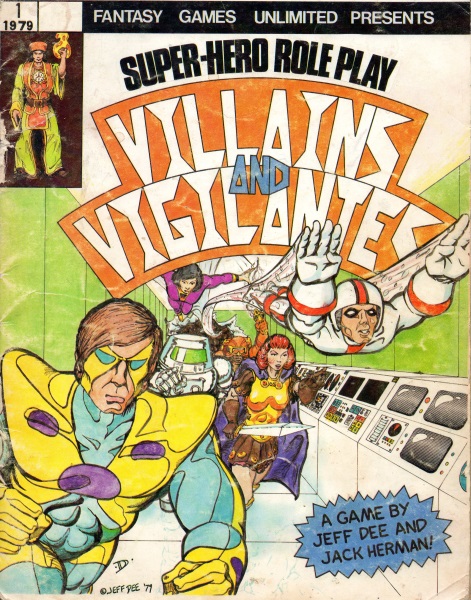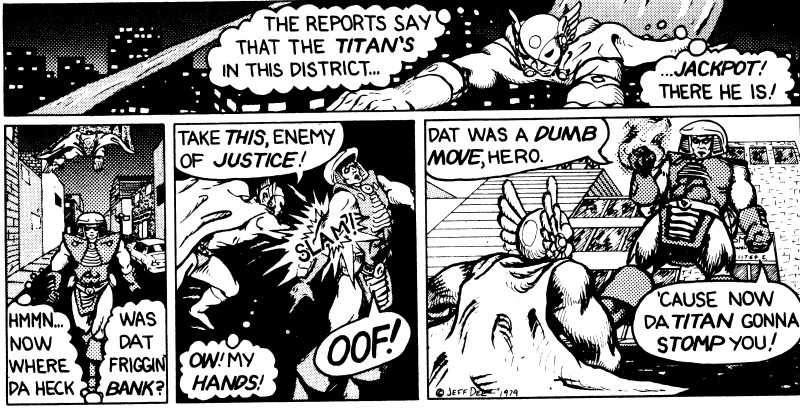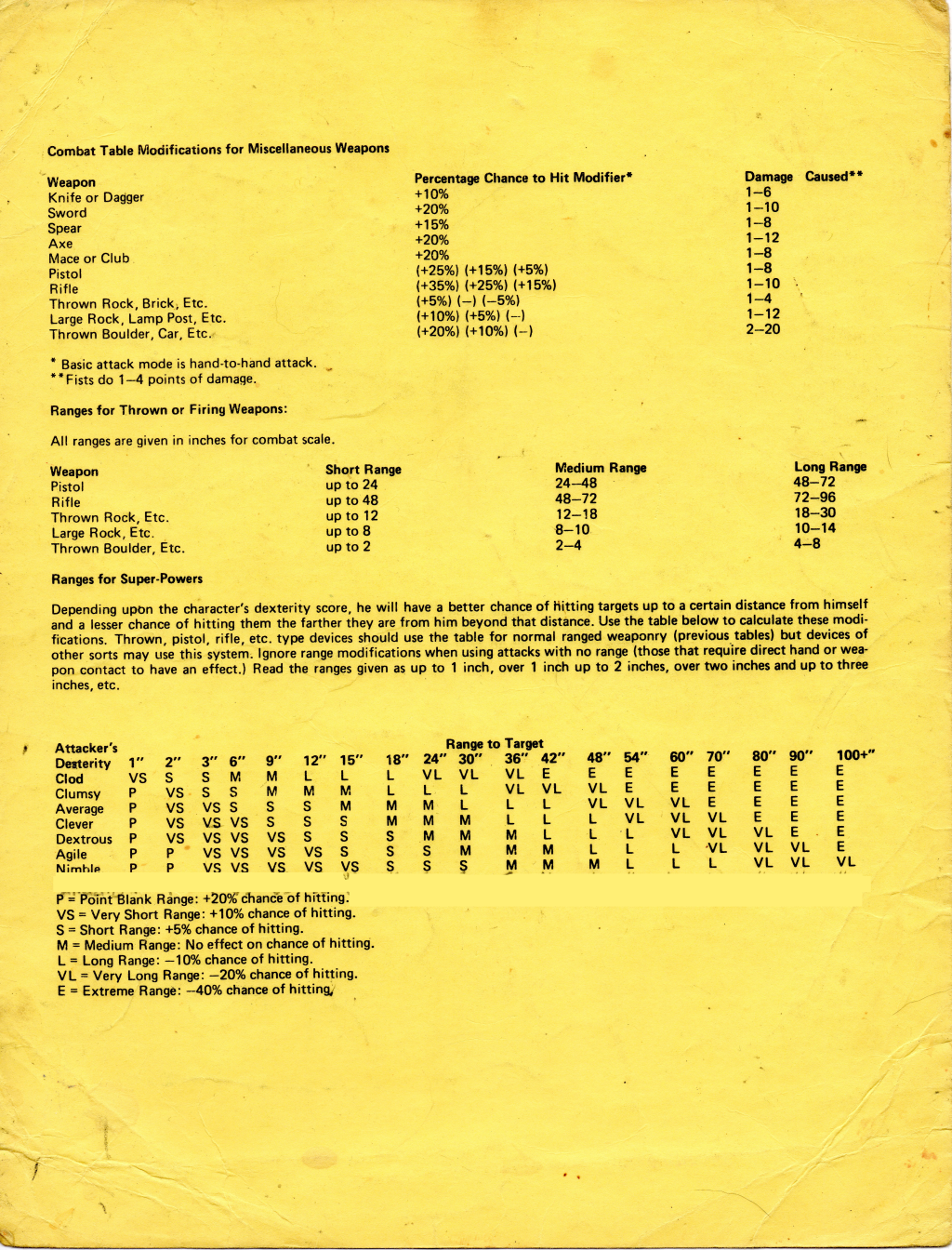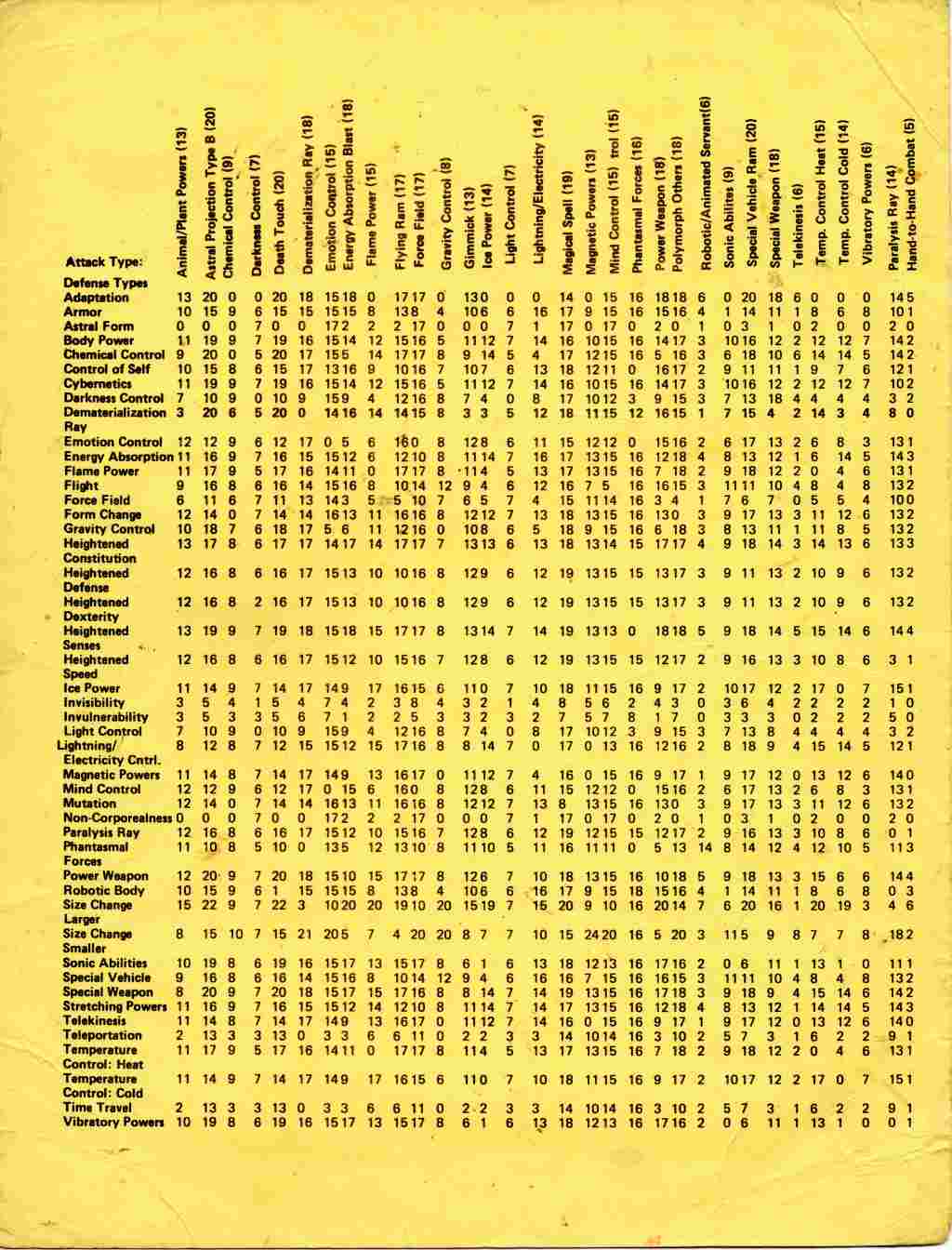Villains and Vigilantes by Humbug Scoolbus
Everything is Random
Original SA post
In 1978 two teenagers had a great idea. This new D&D thing had appeared and was taking nerd-dom by storm, but what if you didn't want to play a fantasy game? What if instead, you wanted to be a superhero?

Villains and Vigilantes was the game of my youth, even more than the the three white book OD&D. I honestly probably played in more V&V games than D&D by the time I had graduated high-school back in 1981. I'm going to be covering the first edition of this game, the very first useable superhero RPG (Sorry, 2044 is not in any way, shape, or form playable as an RPG) and maybe I'll compare the revised edition and Living Legends as an afterword.
Jeff Dee and Jack Herman were in High School in Austin Texas in the late-70s. They had been playing D&D and Traveller and that was cool and all but they really wanted to be superheroes. They started cobbling up their own set of rules and wham there was V&V. They played it, their friends played, they thought maybe other people would want to play it. They got in touch with a company called FGU (Fantasy Games Unlimited) which was acting as a publisher for various writers. FGU had already published a number of miniature rule sets, wargames, and boardgames,], but Bunnies and Burrows was really their only RPG to this point.
Enter Dee and Herman. Two kids from Austin persuaded the owner of FGU, Scott Bizar, to give their game a shot. He did and it became wildly successful, or at least as wildly successful as a TTRPG can get in 1979...
The cover art is by Dee, who became quite a well-known illustrator after this period. He was responsible for the Egyptian Pantheon in the AD&D Deities and Demi-Gods among other things. It's crude as hell, but hey! Full Color cover! It's a small game actually. Only 38 pages and basically un-illustrated (only two small comic strips) with a tip in sheet that will make some people's heads explode.
Let's get started!
The intro page has some good stuff starting from the very first section...
V&V posted:
VILLAINS & VIGILANTES is a role playing game simulating the lives and adventures of a group of comic book style super-heroes. It requires one or more players (anywhere up to a maximum of about ten) and a referee, hereafter called the Gamemaster.
It is the Gamemaster's job to control all non-player characters, to set up encounters for the players, to determine the results of any actions undertaken by the players, and to generally keep the players entertained and the game running smoothly.
At the start of the game the Gamemaster must determine the basic characteristics of each player's character (strength, intelligence, constitution, dexterity and charisma) on a scale of 3 to 18 where an average score is ten or eleven. The method used in doing this differs from most role playing games in that no dice are rolled. The Gamemaster judges each player's actual score from real life and then applies these scores to the player's character. This is because the character in VILLAINS & VIGILANTES is an exact duplicate of the player with the addition of super powers. A short discussion with each player will aid the Gamemaster in evaluating each characteristic, but care must be taken to insure that no character receives anything he does not deserve. Players who feel that they have been 'short changed' may console themselves with the knowledge that these characteristics can be raised through training during the actual game.
Oh yeah that's the stuff...

So you have nerds rating nerds on Strength, Con and the usual other stats. Fortunately the group I gamed with mostly was Graduate students so the stupidity and whining weren't as common.
Next up came the bit about the world background...
V&V posted:
In the dimension where VILLAINS & VIGILANTES is real the planet Earth has undergone a radical shift in reality which allows super powered characters to exist. Previous to the late 1970s that Earth was identical to the one on which you and I now live.
First to appear were the Mutants. Theoretically these characters have always had latent super-powers but required the reality shift before they could discover and use these powers. They soon split into two factions: The Villains who strive for world domination and often do so against one another, and the Vigilantes who use their powers for the betterment of humanity and thus to the detriment of the Villains.
Members of both factions then began to join or form organizations intent on discovering the secret that made super-powers possible. They were only slightly successful in this, for as they devised many mechanisms to reproduce these powers they made few discoveries as to how the human body was able to generate these same powers. Thus, these organizations brought about the 'designed' and 'sponsored' superbeing types. Individuals attempting to copy their experiments to enter the growing class of super-powered humanity became 'homemade' character types.
The individual and organized attempts at super power synthesis would have died out quickly had not evidence existed that non-Mutants were able to gain personal super-powers. That evidence was furnished by the Accidental Scientific origins of the fifth super-being type to appear on Earth. This evidence demonstrated that in rare instances, freak accidents such as electrocution or radiation overexposure could give a normal human being whatever it took to become super-powered.
Additional evidence was discovered in the fact that the acceptance of the reality of the occult and other paranormal phenomena among the general public took a tremendous leap over the same period during which the reality shift had occurred. Investigation brought forth rumors that powerful sorcerers had suddenly appeared throughout the world, some joining the faction of their choice and others retreating into seclusion. A popular theory is that super and psychic powers are closely related, if not the same, though this is still a matter of speculation and under debate by the world's leading scientists.
Somewhere along the line the popularity of the Vigilantes among the general public brought forth the first Charismatically Involved character, and that example has been often. repeated. Meanwhile, government agents, private investigators, and other Non-Powered Adventurer types were drawn into situations with super-powered characters.
Obviously, all this activity on Earth was bound to attract somebody's attention, and it did. Extraterrestrials from the far corners of the galaxy came 'flying' to take a closer look, though some stayed longer than they had originally intended.
That's it, the entire backstory, metaplot, arc, what-have you.
We used maps of our local town (Madison Wisconsin has a ludicrously high percentage of paranormals...Who knew?) and went to heroing.
The next section is Character Generation.
Strength, Intelligence, Constitution, Dexterity, and Charisma. The stats were rated from 3-18 though superpowers could crack those limits in a heartbeat. V&V did make some interesting choices however. It was a level based system and PCs started with a d6 hit points. The thing is your stats could modify those and not just your Constitution. The only stat that didn't modify hit points was Charisma. All the other four affected them. Strength also affected Direct Damage (Hand to Hand basically) and Intelligence and Dexterity affected All Damage.
The other figured statistic was Power Potential or PP. This was how much juice you had to fire blasts or fly or whatever. It was derived by adding all four of the non-suck stats (i.e. everything but Charisma).
After you had figured your stats you rolled a d10 and saw what kind of a hero you were...or at least your origin type.
V&V posted:
MUTANTS
These characters spontaneously developed their super-powers with no apparent outside stimuli. Because they are not always accepted in human society, a roll of 30 or less on percentile dice indicates that they immediately lose one charisma point.
DESIGNED
This character was given his powers by a government or scientific organization and was then let loose upon the world. He still maintains contact with his benefactors and is expected to come to their aid in crisis situations. However, he is generally allowed to handle his own affairs without supervision by his 'creators.'
SPONSORED
This character is similar to the Designed character except that he is permanently employed by his creators and they maintain a large degree of control over how he uses his powers. There is a 30% chance per month that he will be sent on a mission. If he refuses to go, the refereee must determine the consequences. He is paid $100 per week per experience level he has attained and he may not accept rewards, though he gains no charisma or experience for refusing such rewards for his actions (see 4.3.)
HOMEMADE
This character trained himself secretly and created any devices he has completely on his own. While one of the least powerful characters, Homemade characters command great respect if they reach the higher experience levels.
ACCIDENTAL SCIENTIFIC
Accidental Scientific characters have fewer powers than Mutants, but without the possible charisma loss faced by the mutated characters. The types of powers such characters can gain are determined by the type of accident responsible for them.
SUPERNATURAL
These characters studied magical books and forbidden lore in order to master the arts of sorcery. True supernaturals add +2 to their charisma scores due to the aura of fear which surrounds them and the dedication they have demonstrated for their art.
ACCIDENTAL SUPERNATURAL
Such characters have become involved in sorcery through no plan of their own. They have either discovered a magical item of power or have become enchanted by an unknown benefactor, etc. Accidental Supernaturals gain only a +1 charisma bonus, but are not as fanatically dedicated to 'Law' or 'Chaos' as true supernaturals.
Note that the 'chaotic' possibility exists only for non-player characters as all player-characters must abide by the 'comics code.'
CHARISMATIC INVOLVEMENT
These characters contain some sort of (as yet) unidentified characteristic which gives them an automatic and permanent charisma of 17. Their charisma factor cannot change under normal circumstances. The main bonus these characters have is the ability to attach themselves to a vigilante or group of vigilantes and they then act as a form of companion and/or mascot for the vigilantes. High level charismatically involved characters are the kind of people who are hired as secret agents or leaders of secret organizations. They may switch from group to group or from vigilante to vigilante whenever it seems useful. These characters can also train themselves while adventuring, but only up to a maximum factor of 16 in each category of basic characteristics. Like other characters, they must take time off from adventuring to raise their characteristics above sixteen.
Should a charismatically involved character ever find himself in trouble, super-powered individuals of his faction who are in the area must come to his aid. Super-powered groups with such a charismatic character will sustain a one point charisma loss should the charismatic character ever be killed or be permanently taken out of action.
Charismatically involved characters have a 5% chance of having one super power.
NONPOWERED ADVENTURER
Such characters do not really have super-powers, but because of the variety of heightened characteristics and skills they can obtain they are often more than a match for many super-powered beings. A player's first character (that character that is the player's self) cannot have this origin type so that players rolling an origin of this type should reroll for origin type on an eight sided die.
Should a player's original character die, he must roll for a new character and this character can be of this origin type. See section 4.7 for a fuller explanation of rolling up new characters.
Nonpowered adventurers have a 3% chance of having come from another time, dimension, or whatever at the Gamemaster's whim. If this is the case, the Gamemaster determines what, if any characteristics the player will have based on being from wherever or whenever he originated.
If the Nonpowered Adventurer is not from somewhere else, there is a 20% chance that he is already employed by the government.
This can be handled in the same fashion as is the case for Sponsored super-being characters.
EXTRATERRESTRIAL
This character came from another planet and any powers he has are natural to his race. As with Nonpowered Adventurers, a player's first character cannot be of extraterrestrial origin. If such an origin is rolled, players are to reroll with eight sided dice.
Naturally, a character can be rolled with this origin type if the original character of a player has been killed.
The Gamemaster must determine whether or not the Extraterrestrial character maintains any contact with his planet or his race of origin.
The number of powers each character has are determined by their origin types, as are the types of powers characters will obtain.
pre:
Origin Type Number of Powers Obtained Roll on List Mutant 1-6 F Designed 1-4 A Sponsored 1-4 A Homemade 1-4 B Accidental Scientific 1-3 C Supernatural 1-6 D Accidental Supernatural 1-4 E Charismatic Involvement 5% Chance of 1 F Nonpowered Adventurer 2-5 G Extraterrestrial 1-6 F Roll a die to find the number of powers. Then roll for each power on the appropriate list on the following pages. Should the same power be rolled more than once, roll again to find the correct number of different powers.
Power Tables
Original SA post
Time for Powers!
There are 7 Tables labled A-G.
Table A is Gadgets and Devices, B is Enhanced Training/Stat Boosts, some smaller gadgets, and sidekicks/pets, C is Innate Physical or Mental powers, D and E are Fringe powers like Astral Projection, Death Touch and the like. F is a grabbag with something from all the others, and G is like B only with no gadgets or pets.
This comes out to 1 1/2 pages of random tables which I could show you, but would be kind of dumb and a waste of space.
After you roll for the powers you get, the amount received depending on your origin type, the Gamemaster goes through and removes one of them. If you only roll two powers or less, you get to decide. So basically the whole character gen is building your concept around a character rather than the other way around. It sounds awful, but it actually works surprisingly well and you do get some weird-ass heroes on occasion.
The powers run the typical comics gamut: Adaption to Hostile Environments, Heightened Stas (add 2D10 to the indicated stat. If you roll this more than once it can stack), Flight, Energy Blasts, Armor, Super-senses...
The reason I'm not covering them heavily is that they are all, as really should be done in a superhero game, really bare-bones described as to game effects. The player gets to decide what the special effects are.
After the powers list, which is only taking up seven pages including descriptions, we come to training up stats as long as a power hasn't kicked it up over a score of '20'. Then comes a paragraph on costumes and the first piece of art in the book after the cover...

Exciting huh? Well this was the dawn of the RPG after all.
The next section is on secret and public identities and patrolling, then a short blurb on inventions and then the experience chart.
Going up levels increased your hit points, gave an Offense and Defense Bonus which will be touched on in the actual rules section and nothing else really.
Next section we look at the glory of COMBAT!
Combat
Original SA post
Combat in 1st edition V&V.
At first it doesn't sound toooo bad.
You have a choice of one of six actions you can perform in a fifteen second combat turn. Initiative is determined by a d10 +your Dex score simple enough.
The six actions are
A) Move only. Movement is a number of 'inches' that are off of the Dexterity score table. Interestingly it never says how far an 'inch' actually is. We always assumed it was 10' so whatever...
B) Move and perform Hand to Hand attack. Charge!!!!
C) Hand to Hand Attack only.
D) Make us(sic) of a Super-Power, Device, or any powered or firing weapon. Only one attack may be made per turn.
E) Attempt to disengage from Melee. This is automatic if you have fly or increased dex, speed, what have you and the opponent doesn't. It doesn't say what happens if both do though.
F) Go Evasive. Subtract 1+Dex from every attack that is coming in at you.
G) Attempt two of the above actions. This requires a Dex roll or less on a d20.
Compared to Original D&D this is amazingly detailed. Compared to now however...
Facing is important. If somebody hits you from the flank or the rear that get a +20%/+40% bonus to hit. To change facing when it's not your turn requires you to spend 2 Power Points.
Yes this is a percentile based to hit system.
Have a complete list of modifiers...

Yeah aside from the facing which isn't there, that's pretty much all of them. Incidentally FGU games usually came with tipped in cardstock sheets like this. They would have Photocopyable Character Sheets, Campaign Worksheets, and Combat Tables. Gm cheat sheets were really handy for some of them (Space Opera, Daredevils, Aftermath <cough>).
So far, it looks a little clunky but not insane. So what do you need to roll to hit you ask?
Now it gets insane...

Just look at that glorious grog!
Okay, how it works...
The attacker looks along the top row and finds what power they're using say Power Weapon...then you cross-reference five of the powers that the Defender has (Defender's choice which if they have more than five) and add up the corresponding numbers. Say the Defender has Heightened Defense (13), Adaptation (18), and Power Weapon (10) and yes your attacks can factor into your defences which actually is a pretty cool idea come to think of it. That's only three Defences though and you need five. See the Number (18) After Power Weapon in the Attacks row? Well you add that number to the total enough times (2 in this case) to bring the number of Defences up to five so (36). That means the base chance to hit is 13 + 18 + 10 + 18 +18 or 77% before modifiers of course...
Now remember you have to do this for every attack launched by every hero, villain, or mook on the battlefield...
I really can't go on. The flashbacks...the flashbacks....
